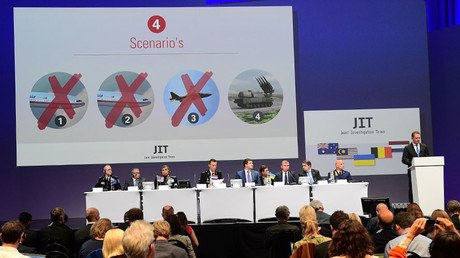Solid facts? 5 flaws that raise doubt over int’l MH17 criminal probe
An international inquiry has found that MH17 was taken down from within rebel-held territories by a BUK system transported from Russia. However, some uncertainty over it lingers – investigators withheld key evidence citing security concerns.
During the presentation of its findings, the Joint Investigation Team (JIT) stated that it would not disclose all the information and evidence sources it used in its inquiry.
“We cannot and do not want to tell you everything because that can jeopardize the investigation and play into the hands of the perpetrators,” the body said.
Unnamed eyewitnesses
According to the JIT the BUK was brought into Ukraine from Russia by a low-loader and then taken to the alleged launch site near Snezhnoye. The cornerstones of this conclusion are open-source materials and “witness statements” gathered by investigators. However no people who provided the statements were named, with the JIT citing security reasons.
The inquiry also mentioned eyewitnesses who allegedly saw the smoke trail following the launch of the BUK near Snezhnoye. The Dutch-led team has not released any video accounts from these people to back up their claims.
Anonymous phone call interceptions
Apart from using eyewitnesses, the international team analyzed “intercepted telephone conversations”. The JIT said it examined “approximately 150,000” intercepted telephone calls, but during its presentation, the international team released the transcripts and audio recordings of only a handful of them. One of the phone calls in particular includes an alleged discussion about the need for a missile system and a confirmation that rebel forces had procured one.
Although the JIT provided the date for the calls it is not clear as to who exactly was involved in the conversation and who handed over the respective data. While the JIT claimed it has independently evaluated their authenticity, Russia, for instance was not included in the process.
Computer simulation vs. video evidence
While stressing that the JIT was able to track “much of the route” of the BUK missile system from Russia, investigators provided only few videos and images of the system, allegedly in Ukraine.
The main evidence on the path of the low-loader with the Buk was hence presented not with real images, but merely a computer reconstruction. It showed the alleged route of the missile system through communities in eastern Ukraine right to the alleged launch site.
READ MORE: Int’l investigators allowed Ukraine to fabricate MH17 evidence – Russia
The investigators also cited the importance of anonymity because of potential security issues for the people who had provided them with materials.
Radar data and satellite images
Pinpointing the exact location of the BUK missile launch was one of the key tasks for the Dutch-led team. In its report investigators cited data received from the US which purported to show that MH17 was downed by a BUK missile “launched from a site about six kilometers south of the village of Snizhne [Snezhnoye].” The images have not been attached to the report.
On September 26 Russia challenged JIT claims releasing raw data from a radar located in Russia, which registered no objects approaching MH17 from the territories held by rebels. Moscow also called on Ukraine to release its radar data, which the Russian Defense Ministry continues to point out, has still not been made public.
Missile type and flight trajectory
On Wednesday the international team reiterated that it could not specify the exact type of missile used to down the Malaysian Boeing, saying it was a 9M38-series rocket.
Yet Russian company Almaz-Antey said it could clearly identify the missile being of type 9M38, which is already decommissioned in Russia, after carrying out experiments last year. That was not reflected in the latest JIT report.
READ MORE: MH17 int’l probe’s only sources are Ukrainian intel & internet - Russian MoD
Almaz-Antey further questioned the JIT report since it had handed over “top-secret” data on BUK missile characteristics to the investigators earlier. Yet the international team opted to study a “similar” US missile to model the impact, which according to Almaz-Antey massively differs from the Russian BUK including a different potential flight path.














